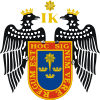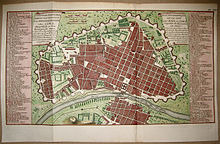| Lima | |
|---|---|
| District | |
 The Cathedral seen from the city's main square The Cathedral seen from the city's main square | |
 Flag Flag Coat of arms Coat of arms | |
| Coordinates: 12°2′36″S 77°1′42″W / 12.04333°S 77.02833°W / -12.04333; -77.02833 | |
| Country | |
| Region | Lima |
| Province | Lima |
| Founded | 1823 |
| Capital | Lima |
| Government | |
| • Mayor | Rafael López Aliaga (2023-present) |
| Area | |
| • Total | 21.88 km (8.45 sq mi) |
| Elevation | 2.87 m (9.42 ft) |
| Population | |
| • Total | 276,482 |
| Time zone | UTC-5 (PET) |
| UBIGEO | 150101 |
| Website | munlima.gob.pe |
Lima (Spanish pronunciation: [ˈli.ma]), also known as the Cercado de Lima, is a district of the eponymous province of Lima, Peru. It is the oldest district of the province and as such, vestiges of the city's Spanish era remain today in the city's historic centre, which was declared a UNESCO World Heritage Site in 1988 and contains the foundational area once surrounded by the city's walls.
History
Main article: History of Lima
The city of Lima was founded by Francisco Pizarro on January 18, 1535, and given the name City of Kings. Nevertheless, with time its original name persisted, which may come from one of two sources: Either the Aymara language lima-limaq (meaning "yellow flower"), or the Spanish pronunciation of the Quechuan word rimaq (meaning "talker", and actually written and pronounced limaq in the nearby Quechua I languages). It is worth nothing that the same Quechuan word is also the source of the name given to the river that feeds the city, the Rímac River (pronounced as in the politically dominant Quechua II languages, with an "r" instead of an "l"). Early maps of Peru show the two names displayed jointly.
Under the Viceroyalty of Peru, the authority of the viceroy as a representative of the Spanish monarchy was particularly important, since its appointment supposed an important ascent and the successful culmination of a race in the colonial administration. The entrances to Lima of the new viceroys were specially lavish. For the occasion, the streets were paved with silver bars from the gates of the city to the Palace of the Viceroy.
In 1988, UNESCO declared the historic centre of Lima a World Heritage Site for its originality and high concentration of historic monuments constructed during the viceregal era. In 2023, it was expanded with two exclaves to include the Quinta and Molino de Presa and the Ancient Reduction of Santiago Apostle of Cercado.
Geography
The district has a total land area of 21.98 km. Its administrative centre is located at 154 meters above sea level.
Boundaries
- North: The Rímac River marks the district's border with the San Martín de Porres and Rímac districts.
- East: San Juan de Lurigancho, El Agustino and San Luis.
- South: La Victoria, Lince, Jesús María, Breña and Pueblo Libre.
- West: San Miguel District; and the Callao Region districts of Bellavista, Callao and Carmen de la Legua Reynoso.
Neighbourhoods

- Central Lima (known as Cercado proper or as the Damero) is limited by Alfonso Ugarte Avenue on the west and Huánuco street on the east. It is divided into West and East sides by the pedestrian Union Street, from which cuadras (city blocks) are numbered beginning at 100 and changing the first numbers at the next block. The main thoroughfares for cars and buses are Tacna Avenue on the West side and Abancay Ave. on the East. Both are separated from the Jirón de la Unión by 4 blocks. The Main Square is located on block 2 of the Jirón de la Unión, facing the Government Palace and the Metropolitan Municipality of Lima (City Hall).
- Barrios Altos is located to the east of the aforementioned centre. Here the oldest, though least stable, buildings in the centre are located. Two cemeteries, El Ángel and Presbítero Maestro, form the eastern border with El Agustino. Parts of the long-demolished colonial city walls can be seen here. Abutting this to the southwest is the city's Chinatown, dating back to the mid-1800s.
- Santa Beatriz is located to the south, which contains residential buildings and the Parque de la Reserva. Santa Beatriz is locally famous for containing the buildings for the state TV network TNP (Ch. 7), and the top two private TV networks, America Television (Ch. 4) and Panamericana Television (Ch. 5). Its main thoroughfare is Arequipa Avenue, a narrow boulevard lined with trees of all sizes. Santa Beatriz is also home to the city (and country)'s main football stadium, the National Stadium.
- The Industrial Area, an industrial belt extending into neighboring Callao Region, is located towards the west, home to the main industries in both city and country. Most of the area is covered by large blocks containing large factories. This area includes the University City of the National University of San Marcos.
At its northern and southern edges, there are clusters of residential areas, particularly in the southern zone bordering Pueblo Libre, San Miguel and Callao Region's Bellavista District.
Demographics

According to a 2005 estimate by the INEI, the district has 278,804 inhabitants and a population density of 15,736.9 persons/km. In 1999, there were 75,595 households in the district.
The high point of Lima's religious calendar for the masses is a month of festivities in October dedicated to the Lord of Miracles, during which take place several processions in the city.
See also
References
- "Estadística Poblacional - Ministerio de Salud del Perú".
- ^ "La inmortal flor de la canela". ABC. Archived from the original on 2004-04-19.
- Augustin, Reinhard (2017). El Damero de Pizarro: El trazo y la forja de Lima (PDF) (in Spanish). Lima: Municipality of Lima. ISBN 978-9972-726-13-2. Retrieved November 3, 2017.
- ^ "Historic Centre of Lima". World Heritage Convention. UNESCO.
External links
- (in Spanish) Municipalidad Metropolitana de Lima Archived 1999-04-20 at the Wayback Machine - Metropolitan Lima Municipal Council official website
- [REDACTED] Geographic data related to Lima District at OpenStreetMap
| Lima Metropolitan Area | |||||||||||||
|---|---|---|---|---|---|---|---|---|---|---|---|---|---|
| Districts |
| ||||||||||||